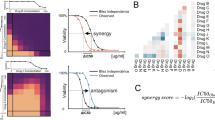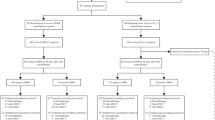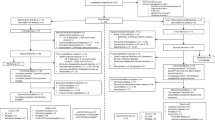Abstract
Acute myeloid leukemia (AML) is an invasive hematopoietic malignancy requiring novel treatment strategies. In this study, we identified phosphodiesterase 3 A (PDE3A) as a potential new target for drug repositioning in AML. PDE3A was preferentially overexpressed in AML cells than in normal cells, and high expression of PDE3A was correlated with lower event-free survival (EFS) in de novo AML patients. The PDE3A inhibitor anagrelide (ANA) profoundly suppresses the proliferation of high PDE3A-expressing AML cells while exhibiting minimal impact on those with low PDE3A expression. Moreover, synergistic effect of ANA with other chemotherapeutic drugs in high PDE3A expression AML cells was observed. The ANA-idarubicin (IDA) combination showed the most remarkable synergistic effect among all ANA-chemotherapeutic drugs commonly used in AML cell line models. Mechanistically, the synergy between ANA and IDA inhibited the survival of PDE3Ahigh AML cell lines through pyroptosis. This mechanism was initiated by GSDME cleavage triggered by caspase-3 activation. In vivo combination treatment of leukemic animals with high PDE3A expression significantly reduced leukemia burden and prolonged survival time compared with single-drug and vehicle control treatments. Our findings suggest that combined ANA and IDA treatment is an innovative and promising therapeutic strategy for AML patients with high PDE3A expression.
This is a preview of subscription content, access via your institution
Access options
Subscribe to this journal
Receive 12 print issues and online access
$259.00 per year
only $21.58 per issue
Buy this article
- Purchase on SpringerLink
- Instant access to full article PDF
Prices may be subject to local taxes which are calculated during checkout







Similar content being viewed by others
Data availability
Our sequencing and processed data files were submitted to the Gene Expression Omnibus (GEO; http://www.ncbi.nlm.nih.gov/geo/) repository GSE269021 (RNA-seq). Other relevant data are available from the corresponding authors upon reasonable request.
References
Döhner H, Weisdorf DJ, Bloomfield CD. Acute myeloid leukemia. N Engl J Med. 2015;373:1136–52. https://doi.org/10.1056/NEJMra1406184
He X, Zhu Y, Lin YC, Li M, Du J, Dong H, et al. PRMT1-mediated FLT3 arginine methylation promotes maintenance of FLT3-ITD(+) acute myeloid leukemia. Blood. 2019;134:548–60. https://doi.org/10.1182/blood.2019001282
Rubnitz JE, Kaspers GJL. How I treat pediatric acute myeloid leukemia. Blood. 2021;138:1009–18. https://doi.org/10.1182/blood.2021011694
Pui CH, Mullighan CG, Evans WE, Relling MV. Pediatric acute lymphoblastic leukemia: where are we going and how do we get there? Blood. 2012;120:1165–74. https://doi.org/10.1182/blood-2012-05-378943
Mezouar S, Darbousset R, Dignat-George F, Panicot-Dubois L, Dubois C. Inhibition of platelet activation prevents the P-selectin and integrin-dependent accumulation of cancer cell microparticles and reduces tumor growth and metastasis in vivo. Int J Cancer. 2015;136:462–75. https://doi.org/10.1002/ijc.28997
Zhang X, Xu H, Bi X, Hou G, Liu A, Zhao Y, et al. Src acts as the target of matrine to inhibit the proliferation of cancer cells by regulating phosphorylation signaling pathways. Cell Death Dis. 2021;12:931. https://doi.org/10.1038/s41419-021-04221-6
Foss B, Bruserud O. Platelet functions and clinical effects in acute myelogenous leukemia. Thromb Haemost. 2008;99:27–37. https://doi.org/10.1160/TH07-04-0240
Cacic D, Nordgård O, Meyer P, Hervig T. Platelet microparticles decrease daunorubicin-induced DNA damage and modulate intrinsic apoptosis in THP-1 cells. Int J Mol Sci. 2021;22:7264. https://doi.org/10.3390/ijms22147264
Zhang W, Colman RW. Thrombin regulates intracellular cyclic AMP concentration in human platelets through phosphorylation/activation of phosphodiesterase 3A. Blood. 2007;110:1475–82. https://doi.org/10.1182/blood-2006-10-052522
An R, Liu J, He J, Wang F, Zhang Q, Yu Q. PDE3A inhibitor anagrelide activates death signaling pathway genes and synergizes with cell death-inducing cytokines to selectively inhibit cancer cell growth. Am J Cancer Res. 2019;9:1905–21.
Colman RW. Platelet cyclic adenosine monophosphate phosphodiesterases: targets for regulating platelet-related thrombosis. Semin Thromb Hemost. 2004;30:451–60. https://doi.org/10.1055/s-2004-833480
Yan B, Ding Z, Zhang W, Cai G, Han H, Ma Y, et al. Multiple PDE3A modulators act as molecular glues promoting PDE3A-SLFN12 interaction and induce SLFN12 dephosphorylation and cell death. Cell Chem Biol. 2022;29:958–69.e5. https://doi.org/10.1016/j.chembiol.2022.01.006
Hao N, Shen W, Du R, Jiang S, Zhu J, Chen Y, et al. Phosphodiesterase 3A represents a therapeutic target that drives stem cell-like property and metastasis in breast cancer. Mol Cancer Ther. 2020;19:868–81. https://doi.org/10.1158/1535-7163.MCT-18-1233
Zhong F, Liu J, Gao C, Chen T, Li B. Downstream regulatory network of MYBL2 mediating its oncogenic role in melanoma. Front Oncol. 2022;12:816070. https://doi.org/10.3389/fonc.2022.816070
Tian FM, Zhong CY, Wang XN, Meng Y. PDE3A is hypermethylated in cisplatin resistant non-small cell lung cancer cells and is a modulator of chemotherapy response. Eur Rev Med Pharm Sci. 2017;21:2635–41.
Storen EC, Tefferi A. Long-term use of anagrelide in young patients with essential thrombocythemia. Blood. 2001;97:863–6. https://doi.org/10.1182/blood.v97.4.863
Tomer A. Effects of anagrelide on in vivo megakaryocyte proliferation and maturation in essential thrombocythemia. Blood. 2002;99:1602–9. https://doi.org/10.1182/blood.v99.5.1602
Pulkka OP, Gebreyohannes YK, Wozniak A, Mpindi JP, Tynninen O, Icay K, et al. Anagrelide for gastrointestinal stromal tumor. Clin Cancer Res. 2019;25:1676–87. https://doi.org/10.1158/1078-0432.CCR-18-0815
Chen J, Liu N, Huang Y, Wang Y, Sun Y, Wu Q, et al. Structure of PDE3A-SLFN12 complex and structure-based design for a potent apoptosis inducer of tumor cells. Nat Commun. 2021;12:6204. https://doi.org/10.1038/s41467-021-26546-8
Meanwell NA. Anagrelide: a clinically effective cAMP phosphodiesterase 3A inhibitor with molecular glue properties. ACS Med Chem Lett. 2023;14:350–61. https://doi.org/10.1021/acsmedchemlett.3c00092
de Waal L, Lewis TA, Rees MG, Tsherniak A, Wu X, Choi PS, et al. Identification of cancer-cytotoxic modulators of PDE3A by predictive chemogenomics. Nat Chem Biol. 2016;12:102–8. https://doi.org/10.1038/nchembio.1984
Garvie CW, Wu X, Papanastasiou M, Lee S, Fuller J, Schnitzler GR, et al. Structure of PDE3A-SLFN12 complex reveals requirements for activation of SLFN12 RNase. Nat Commun. 2021;12:4375. https://doi.org/10.1038/s41467-021-24495-w
Wu X, Schnitzler GR, Gao GF, Diamond B, Baker AR, Kaplan B, et al. Mechanistic insights into cancer cell killing through interaction of phosphodiesterase 3A and schlafen family member 12. J Biol Chem. 2020;295:3431–46. https://doi.org/10.1074/jbc.RA119.011191
Li D, Chen J, Ai Y, Wang Y, Sun Y, Wu Q, et al. Estrogen-related hormones induce apoptosis by stabilizing Schlafen-12 protein turnover. Mol Cell. 2019;75:1103–16.e9. https://doi.org/10.1016/j.molcel.2019.06.040
Ai Y, He H, Chen P, Yan B, Zhang W, Ding Z, et al. An alkaloid initiates phosphodiesterase 3A-schlafen 12 dependent apoptosis without affecting the phosphodiesterase activity. Nat Commun. 2020;11:3236. https://doi.org/10.1038/s41467-020-17052-4
Dos Santos C, McDonald T, Ho YW, Liu H, Lin A, Forman SJ, et al. The Src and c-Kit kinase inhibitor dasatinib enhances p53-mediated targeting of human acute myeloid leukemia stem cells by chemotherapeutic agents. Blood. 2013;122:1900–13. https://doi.org/10.1182/blood-2012-11-466425
Liu J, Ren G, Li K, Liu Z, Wang Y, Chen T, et al. The Smad4-MYO18A-PP1A complex regulates β-catenin phosphorylation and pemigatinib resistance by inhibiting PAK1 in cholangiocarcinoma. Cell Death Differ. 2022;29:818–31. https://doi.org/10.1038/s41418-021-00897-7
Low HB, Wong ZL, Wu B, Kong LR, Png CW, Cho YL, et al. DUSP16 promotes cancer chemoresistance through regulation of mitochondria-mediated cell death. Nat Commun. 2021;12:2284. https://doi.org/10.1038/s41467-021-22638-7
Marks BA, Pipia IM, Mukai C, Horibata S, Rice EJ, Danko CG, et al. GDNF-RET signaling and EGR1 form a positive feedback loop that promotes tamoxifen resistance via cyclin D1. BMC Cancer. 2023;23:138. https://doi.org/10.1186/s12885-023-10559-1
Liu Y, Kimpara S, Hoang NM, Daenthanasanmak A, Li Y, Lu L, et al. EGR1-mediated metabolic reprogramming to oxidative phosphorylation contributes to ibrutinib resistance in B-cell lymphoma. Blood. 2023;142:1879–94.
Ren Q, Guo F, Tao S, Huang R, Ma L, Fu P. Flavonoid fisetin alleviates kidney inflammation and apoptosis via inhibiting Src-mediated NF-κB p65 and MAPK signaling pathways in septic AKI mice. Biomed Pharmacother. 2020;122:109772. https://doi.org/10.1016/j.biopha.2019.109772
Yang S, Li F, Lu S, Ren L, Bian S, Liu M, et al. Ginseng root extract attenuates inflammation by inhibiting the MAPK/NF-κB signaling pathway and activating autophagy and p62-Nrf2-Keap1 signaling in vitro and in vivo. J Ethnopharmacol. 2022;283:114739. https://doi.org/10.1016/j.jep.2021.114739
Cao Y, Chen J, Ren G, Zhang Y, Tan X, Yang L. Punicalagin prevents inflammation in LPS-induced RAW264.7 macrophages by inhibiting FoxO3a/Autophagy signaling pathway. Nutrients. 2019;11:2794. https://doi.org/10.3390/nu11112794
Yu P, Zhang X, Liu N, Tang L, Peng C, Chen X. Pyroptosis: mechanisms and diseases. Signal Transduct Target Ther. 2021;6:128. https://doi.org/10.1038/s41392-021-00507-5
Bertheloot D, Latz E, Franklin BS. Necroptosis, pyroptosis and apoptosis: an intricate game of cell death. Cell Mol Immunol. 2021;18:1106–21. https://doi.org/10.1038/s41423-020-00630-3
Huang Y, Xu W, Zhou R. NLRP3 inflammasome activation and cell death. Cell Mol Immunol. 2021;18:2114–27. https://doi.org/10.1038/s41423-021-00740-6
Wang Y, Kanneganti TD. From pyroptosis, apoptosis and necroptosis to panoptosis: a mechanistic compendium of programmed cell death pathways. Comput Struct Biotechnol J. 2021;19:4641–57. https://doi.org/10.1016/j.csbj.2021.07.038
Paris A, Tardif N, Baietti FM, Berra C, Leclair HM, Leucci E, et al. The AhR-SRC axis as a therapeutic vulnerability in BRAFi-resistant melanoma. EMBO Mol Med. 2022;14:e15677. https://doi.org/10.15252/emmm.202215677
Jin AL, Zhang CY, Zheng WJ, Xian JR, Yang WJ, Liu T, et al. CD155/SRC complex promotes hepatocellular carcinoma progression via inhibiting the p38 MAPK signalling pathway and correlates with poor prognosis. Clin Transl Med. 2022;12:e794. https://doi.org/10.1002/ctm2.794
Peng Z, Wang P, Song W, Yao Q, Li Y, Liu L, et al. GSDME enhances cisplatin sensitivity to regress non-small cell lung carcinoma by mediating pyroptosis to trigger antitumor immunocyte infiltration. Signal Transduct Target Ther. 2020;5:159. https://doi.org/10.1038/s41392-020-00274-9
Ren J, Tao Y, Peng M, Xiao Q, Jing Y, Huang J, et al. Targeted activation of GPER enhances the efficacy of venetoclax by boosting leukemic pyroptosis and CD8+ T cell immune function in acute myeloid leukemia. Cell Death Dis. 2022;13:915. https://doi.org/10.1038/s41419-022-05357-9
Wang Y, Gao W, Shi X, Ding J, Liu W, He H, et al. Chemotherapy drugs induce pyroptosis through caspase-3 cleavage of a gasdermin. Nature. 2017;547:99–103. https://doi.org/10.1038/nature22393
Jiang M, Qi L, Li L, Li Y. The caspase-3/GSDME signal pathway as a switch between apoptosis and pyroptosis in cancer. Cell Death Discov. 2020;6:112. https://doi.org/10.1038/s41420-020-00349-0
Zhang Z, Zhang Y, Xia S, Kong Q, Li S, Liu X, et al. Gasdermin E suppresses tumour growth by activating anti-tumour immunity. Nature. 2020;579:415–20. https://doi.org/10.1038/s41586-020-2071-9
Acknowledgements
We thank the editor, April Jade, servicing at www.editage.cn who provided a deep revision of the manuscript.
Funding
This study was supported by the following grants: The National Key Research and Development Program of China (no. 2022YFC2502700), Jiangsu Key project, BE2021654 to Shaoyan Hu, the National Natural Science Foundation of China (NSFC 82100229 to Yuanyuan Tian, 82200177 to Li Gao, 82170218, and 81970163 to Shaoyan Hu, 31830051 and 32370810 to Sudan He), and Suzhou Projects (GSWS2020039, 2020ZKPB02 to Shaoyan Hu, GSWS 2023048 to Yixin Hu), and the Suzhou Municipal Key Laboratory (SZS201615,SZS2023014 to Shaoyan Hu, SZS2022005 to Sudan He), and the Chinese Academy of Medical Sciences (CAMS) Innovation Fund for Medical Sciences (2022-I2M-2-004, 2021-I2M-1-041, 2021-I2M-1-047, and 2021-I2M-1-061), and the NCTIB Fund for R&D platform for Cell and Gene Therapy.
Author information
Authors and Affiliations
Contributions
C.Y., X.H., and Y.T. conceived the study and analyzed data; C.Y. and Z.L. performed RNA-seq; C.Y. and M.L. performed the western blotting procedure; C.Y. and R.Z. performed animal studies; S.H., C.Y., J.L., L.G., Y.Z., H.L., Y.D., and Q.J. provided clinical AML samples and collected patient information; L.G., and C.Y. conceived the experiments, S.H., Y.T., J.P., and J.L. helped organize the paper and conceived the experiments, C.Y., Y.T., P.X. S.H., and S.H. designed the study and wrote the manuscript.
Corresponding authors
Ethics declarations
Competing interests
The authors declare no competing interests.
Ethics approval and consent to participate
Patient: This study was approved by the Ethics Committee of the Children’s Hospital of Soochow University (No. 2017047-3) and was in accordance with Declaration of Helsinki. Informed consent was obtained from the parents or legal guardians and participants. Animal: All animal experiments were conducted in compliance with the animal care guidelines approved by the Institutional Laboratory Animal Care and Use Committee of Soochow University (SUDA20230802A05) and were in accordance with the ARRIVE guidelines.
Additional information
Publisher’s note Springer Nature remains neutral with regard to jurisdictional claims in published maps and institutional affiliations.
Supplementary information
Rights and permissions
Springer Nature or its licensor (e.g. a society or other partner) holds exclusive rights to this article under a publishing agreement with the author(s) or other rightsholder(s); author self-archiving of the accepted manuscript version of this article is solely governed by the terms of such publishing agreement and applicable law.
About this article
Cite this article
Yang, C., Hu, Y., Gao, L. et al. Anagrelide and idarubicin combination induces GSDME-mediated pyroptosis as a potential therapy for high-PDE3A acute myeloid leukemia. Leukemia 39, 98–111 (2025). https://doi.org/10.1038/s41375-024-02437-x
Received:
Revised:
Accepted:
Published:
Issue date:
DOI: https://doi.org/10.1038/s41375-024-02437-x



